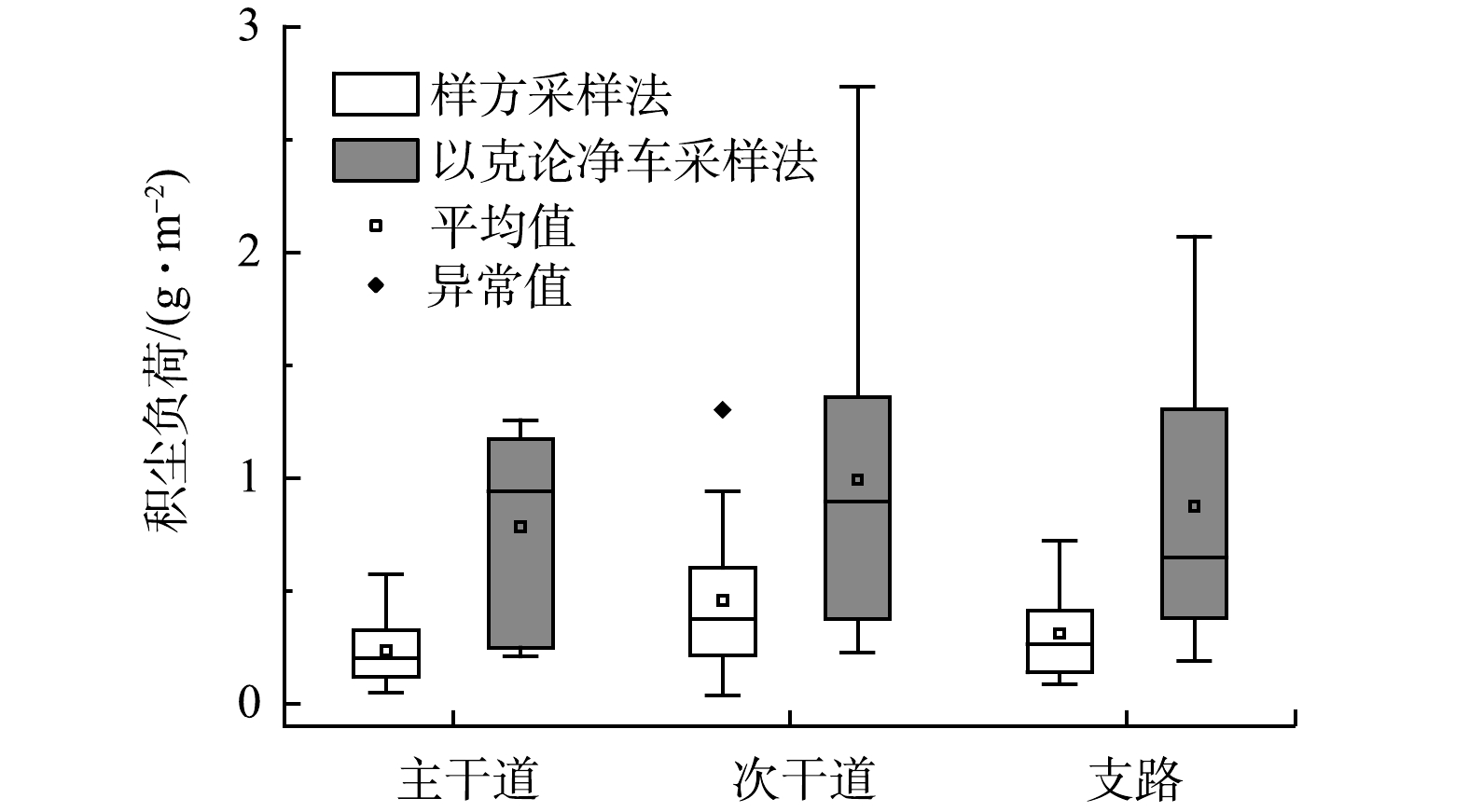-
由于我国北方地区雾霾现象频发,因此,大气颗粒物污染引起了社会各界的广泛关注[1-4]。道路扬尘作为大气颗粒物的重要来源,其影响日益严重[5-7]。已有研究[8-9]表明,道路扬尘对大气细颗粒物的贡献率高达20%,并影响空气质量[10]、能见度[11- 12]以及人体健康[13-15]。因此,了解道路扬尘排放规律与构建道路扬尘排放清单,有利于制定相关污染防控措施[16-17],为有效治理颗粒物污染提供重要依据[18-19]。
作为道路扬尘排放清单中的重要参数,积尘负荷是环境管理的重要抓手[20]。《防治城市扬尘污染技术规范》(HJ/T 393-2007)[21]指出,道路积尘负荷是指单位面积的道路上能够通过75 μm筛的道路积尘的质量,它是道路表面清洁度的表征参数,其大小直接影响道路扬尘的排放量。目前,道路扬尘主要的采样方法包括降尘法、样方吸尘法、快速检测法和移动吸尘法。样方吸尘法包括普通样方吸尘法和以克论净车样方吸尘法(普通样方吸尘法亦称“样方采样法”,以克论净车样方吸尘法亦称“以克论净车采样法”)。样方采样法耗时、耗力并且安全性较低,但因其简便易行,较多地被应用于道路扬尘排放清单和来源解析研究中。潘研等[22]采用样方采样法采集了北京市西城区、海淀区、门头沟区夏季不同类型道路积尘,计算积尘负荷和粒度乘数,得到北京市不同类型道路的PM2.5、PM10排放因子和排放强度;张伟等[23]采用样方采样法,得到了天津市不同道路类型以及不同车道的积尘负荷,并分析了积尘负荷的变化规律。以克论净车采样法耗时短、安全性高、成本高,目前多用于城市清扫保洁例行考核中。北京市、天津市、中卫市等多个城市均采用以克论净车采样法评估城市道路积尘[24]。国内外学者大多集中在对于道路扬尘排放特征的研究[5-19,25-28],而对于道路扬尘排放清单中的重要参数分布特征的研究较少。
本研究在已有研究的基础上,针对道路扬尘排放清单中积尘负荷这一重要参数,研究其分布规律,因车流量[29]、道路清扫规定[30]等差异,使用样方采样法和以克论净车采样法,采集北京市东城区、朝阳区、大兴区的主干道、次干道和支路3种道路类型共11条道路的扬尘样品,对原始样品过筛称重,计算不同车道以及不同道路类型的积尘负荷,探究积尘负荷的空间分布特征和2种采样方法积尘负荷的差异,旨在为遴选道路扬尘采样方法、构建北京市道路扬尘排放清单和制定管控措施提供支持。
-
采样时间为2018年7月20—22日。
采样地点为北京市东城区(首都功能核心区)、朝阳区(城市功能拓展区)、大兴区(城市发展新区)。采样道路选择主干道、次干道、支路等。每种道路类型选择3~4条道路,共选择了11条道路,分别是北土城路、广渠门内大街、左安门内大街、龙潭东路、永定门外大街、北湖渠路、太阳宫北街、兴华大街、双高路、兴和街、宏康路。采样典型道路信息见表1,采样点位及现场见图1。在布设采样点时,每条道路在道路最右侧的机动车道慢车道和快车道(临近慢车道)分别设3个采样点,采样点间相距一般大于800 m;采样点位置尽量避开公交车站、路口等人流密集处。
-
实验仪器:800 W真空吸尘器、电瓶、1 m2采样框、以克论净车(自带0.1 m2采样框,样品通过车载吸尘器(2 000 W)直接吸入采样袋)、万分之一电子天平、柔软细毛刷、样品袋、10目和200目泰勒标准筛等。
样方采样法:使用电瓶供电,采用真空吸尘器在采样点位横竖方向吸尘2遍,采样效率约为2 min·m−2,采样面积一般为2 m2;吸尘结束后,用柔软细毛刷将尘土扫入样品袋中,记录编号并保存备用。
以克论净车采样法:使用汽车供电,仅采集慢车道,于样方采样法相应位置附近自动采样,采样面积一般为0.6 m2;吸尘结束后,直接取下采样袋,记录编号并保存备用。
将采集的原始样品按照以下步骤进行处理:1)去除树叶、烟头及杂物等,放置于干燥器内平衡干燥3 d;2)将850 μm、75 μm泰勒标准筛放入电动振筛机内,样品倒入850 μm筛中;3)振荡电动振筛机20 min后,取出标准筛,称量2个标准筛上样品的质量并记录。
-
积尘负荷计算方法[31]见式(1)。
式中: Q为积尘负荷,g·m−2;m为道路扬尘样品质量,g;m850为850 μm 泰勒标准筛筛上物的质量,g; m75为75 μm泰勒标准筛筛上物的质量,g;S为采样面积, m2。
-
基于样方采样法和以克论净车采样法的不同道路类型慢车道积尘负荷计算结果如图2所示。由图2可以看出,基于样方采样法的北京市夏季不同道路类型积尘负荷的平均值分别为主干道((0.24±0.16) g·m−2),次干道((0.46±0.35) g·m−2),支路((0.31±0.21) g·m−2); 基于以克论净车采样法的北京市夏季不同道路类型积尘负荷的平均值分别为主干道((0.78±0.40) g·m−2),次干道((0.99±0.80) g·m−2),支路((0.88±0.68) g·m−2)。2种采样方法的北京市夏季不同道路类型积尘负荷的平均值从大到小顺序均为次干道>支路>主干道。道路积尘负荷不仅受道路长度、破损、绿化状况的影响,周边环境、道路车流状况[32-34]、车速[35]及控制措施的实施也会影响道路积尘负荷。其中,次干道与支路路面较窄,路面停车现象常见,不便于清扫,且车流量较小,车速较慢,道路不易起尘;而主干道路面较宽,清扫作业方便,且车流量较大,车速较快导致积尘负荷相对较小。
本研究利用SPSS 22.0软件分析2种不同采样方式得到的慢车道积尘负荷差异显著性。开展2个相关样本的非参数检验,检验结果为P=0.00 (P<0.05),表明2种采样方法间积尘负荷差异的检验结果具有显著性。基于2种采样方法的北京市夏季不同道路类型积尘负荷差异较大。由于以克论净车采样法自带的车载吸尘器功率大,路面深层积尘容易被吸起,因此以克论净车采样法的积尘负荷量普遍高于样方采样法。
运用SPSS 22.0软件对2种采样方法得到的积尘负荷量进行Spearman相关性分析,得出P=0.00 (P<0.05)。这说明样方采样法和以克论净车采样法得到的积尘负荷呈线性关系。对2种采样方法的积尘负荷进行线性拟合,拟合结果如图3所示。由图3可以看出,2种采样方法具有相关性。以克论净车采样法成本较高,目前在道路扬尘排放清单编制工作中并不常用,但样方采样法简便易行,较多地被应用于道路扬尘排放清单和来源解析研究中,因此,在后续道路扬尘清单编制过程中,可以使用以克论净车采样法的结果,计算得到样方采样法的积尘负荷。
将基于样方采样法的北京市夏季的积尘负荷分别与石家庄市夏季[35]、乌鲁木齐市夏季[36]、天津市夏季[37]、西安市夏季[38]、北京市[39]积尘负荷做比较,结果如表2所示。可以看出,北京市不同类型道路积尘负荷值稍高于天津市,低于石家庄市、乌鲁木齐市、西安市,结果与樊守彬等[39]得到的北京市全年积尘负荷量相似。这可能是采样方法、采样季节空气质量、控制措施等影响因素导致的。同时北京市与天津市道路建设相对完善,绿化带、绿化施工相对规范,城市道路已使用机械清扫新工艺并加大郊区公路保洁力度[40-42],使得道路积尘负荷量较小,而其他城市道路建设不够完善,保洁作业力度不强,道路积尘负荷量较大。对比本研究中北京市夏季积尘负荷值与《防治城市扬尘污染技术规范》(HJ/T 393-2007)[21]中提到的道路积尘负荷限定标准参考值(表3),可以看出,北京市道路积尘负荷值均处于“优”水平,积尘负荷得到有效控制。
-
基于2种采样方法的北京市朝阳区、东城区、大兴区慢车道积尘负荷的计算结果如图4所示。由图4可以看出,基于样方采样法的北京市夏季不同行政区铺装道路积尘负荷的平均值分别为东城区((0.26±0.23) g·m−2),朝阳区((0.38±0.35) g·m−2),大兴区((0.39±0.23) g·m−2); 基于以克论净车采样法的北京市夏季不同行政区铺装道路积尘负荷的平均值分别为东城区((0.92±0.85) g·m−2),朝阳区((1.00±0.70) g·m−2),大兴区((1.83±2.03) g·m−2)。2种采样方法的北京市夏季不同行政区铺装道路积尘负荷水平由大到小排序均为大兴区>朝阳区>东城区。东城区属于首都功能核心区,实施限行政策,车流量相对较少且以小型车为主,路面建设较为完善,道路洒水保洁频次高[43]。而积尘负荷较高的朝阳、大兴二区分别属于城市功能拓展区和城市发展新区,道路建设及洒水保洁不及核心区,从而导致较高的积尘负荷;大兴区的道路积尘负荷最高,原因在于大兴区有较多工业园区,如亦庄经济开发区、西京工业园、西毓工业园等,因此,工地、工厂较为密集,施工过程产生颗粒物或大型货车运输沿途遗撒等均会产生较高路面积尘负荷。基于2种采样方法的北京市夏季不同城区积尘负荷差异较大,其原因也受2种采样方法所使用的吸尘器功率差异的影响。
为了验证不同行政区积尘负荷差异是否具有统计学意义,运用 SPSS 22. 0软件分别对2种采样方法的朝阳区、东城区、大兴区的道路积尘负荷进行2个独立样本非参数检验,结果如表4所示。由表4可以看出,朝阳区、东城区及朝阳区的非参数检验的P值均大于0.05,检验结果不具有显著性。
-
基于样方采样法的北京市夏季机动车慢车道与机动车快道车的道路积尘负荷计算结果如图5所示。可以看出,机动车慢车道与机动车快车道积尘负荷分别为0.04~1.30 g·m−2 和0.02~1.08 g·m−2。对于同一条道路,慢车道的积尘负荷整体水平稍高于快车道的积尘负荷。对主干道,慢车道积尘负荷明显大于快车道,慢车道是快车道的2.0倍;对次干道,慢车道积尘负荷与快车道相近。这一现象产生的主要原因是慢车道车速低,不易引起积尘扬起,故道路积尘负荷较高; 另外,慢车道接近道路边缘, 绿化带及路边裸露土壤因降水及风力等作用更容易进入慢车道,影响其积尘负荷;同时,主干道快车道车速快,易将快车道的积尘扬起至慢车道。可见,积尘负荷主要受车速及车流量等因素的综合影响。
为研究采集的北京市快慢2个车道的8条(不包括支路)采样道路不同车道积尘负荷的差异情况是否具有统计学意义,运用SPSS 22. 0软件对其进行2个相关样本的非参数检验。结果表明,P= 0. 51>0. 05,故不同车道积尘负荷的差异的检验结果不具有显著性。
-
1)基于样方采样法和以克论净车采样法采集的北京市夏季不同道路类型积尘负荷从大到小顺序为次干道>支路>主干道。2种方法对北京市不同道路类型的积尘负荷进行相关样本非参数检验, 可知2种采样方法间积尘负荷差异的检验结果具有显著性。以克论净车采样法(y)和样方采样法(x)的关系式为y=0.45x-0.09,R2值为0.68。
2)基于样方采样法和以克论净车采样法采集的北京市夏季不同城区铺装道路积尘负荷水平排序为大兴区>朝阳区>东城区。朝阳区、东城区及大兴区差异的检验结果均不具有显著性。
3)基于样方采样法的机动车慢车道与机动车快车道积尘负荷分别为0.04~1.30 g·m−2 和0.02~1.08 g·m−2。北京市夏季慢车道积尘负荷整体水平略高于快车道,2种类型车道非参数检验结果表明其差异的检验结果不具有显著性。
基于2种采样方法的北京市夏季道路扬尘的监测及积尘负荷分布特征
Monitoring and distribution characteristics of dust load on roads in Beijing during summer based on two sampling methods
-
摘要: 为探究不同采样方法对积尘负荷结果的影响,使用样方采样法和以克论净车采样法采集2018年夏季样品的数据,对北京市3个行政区的11条道路扬尘样品进行现场监测,计算不同道路类型及不同车道的积尘负荷,并对积尘负荷的变化规律进行分析。结果表明:基于样方采样法和以克论净车采样法的北京市夏季不同道路类型积尘负荷从大到小顺序依次为次干道(0.46 g·m−2、0.99 g·m−2) >支路(0.31 g·m−2、0.88 g·m−2)>主干道(0.24 g·m−2、0.78 g·m−2);2种采样方法所得积尘负荷差异的检验结果具有显著性(P=0.00<0.05)且存在线性关系;北京市夏季道路积尘负荷(0.34 g·m−2)稍高于天津市(0.24 g·m−2),低于石家庄市(1.06 g·m−2)、乌鲁木齐市(0.96 g·m−2)和西安市(0.70 g·m−2);基于样方采样法和以克论净车采样法采集的不同城区道路积尘负荷水平排序为大兴区(0.39 g·m−2、1.83 g·m−2)>朝阳区(0.38 g·m−2、1.00 g·m−2)>东城区(0.26 g·m−2、0.92 g·m−2),朝阳区、东城区和大兴区积尘负荷差异的检验结果均不具有显著性(P>0.05);基于样方采样法的机动车慢车道与机动车快车道积尘负荷分别为0.04~1.30 g·m−2和0.02~1.08 g·m−2;慢车道积尘负荷略高于快车道,但二者差异的检验结果不具有显著性(P=0.51>0. 05)。本研究成果可为遴选道路扬尘采样方法、构建北京市道路扬尘排放清单和制定管控措施提供参考。Abstract: In order to explore the effect of different sampling methods on the results of road dust load(RDL), the data of the samples in the summer of 2018 were collected by the quadrat method and quantitative net car sampling method. On-site monitoring was carried out on 11 road dust samples in 3 administrative districts of Beijing. The RDLs of different road types and lanes were calculated, and then their variations were analyzed. The results showed that the descending order of RDLs in different road types of Beijing during summer was main lines (0.46 g·m−2, 0.99 g·m−2) > branch roads (0.31 g·m−2, 0.88 g·m−2)> main road (0.24 g·m−2, 0.78 g·m−2) based on the quadrat method and quantitative net car sampling method. A significant difference in RDLs between two sampling methods occurred (P=0.00<0.05), and a linear relationship also appeared. The summer RDLs in Beijing (0.34 g·m−2) was slightly higher than that in Tianjin (0.24 g·m−2), but lower than that in Shijiazhuang (1.06 g·m−2), Urumqi (0.96 g·m−2) and Xi'an (0.70 g·m−2); the collected RDL level in different urban areas based on the quadrat method and quantitative net car sampling method was ranked as Daxing District (0.39 g·m−2, 1.83 g·m−2) > Chaoyang District (0.38 g·m−2, 1.00 g·m−2) > Dongcheng District (0.26 g·m−2, 0.92 g·m−2), and insignificant difference in RDLs among Chaoyang District, Dongcheng District and Daxing District occurred(P>0.05). Based on the quadrat method, the RDLs in slow lane and fast lane for motor vehicles were 0.04~1.30 g·m−2 and 0.02~1.08 g·m−2, respectively. The overall RDL level in slow lanes was slightly higher than that in the fast lanes, but their difference was not significant(P=0.51>0.05). The results of this study provide a reference for the selection of road dust sampling methods, the construction of the Beijing road dust emission inventory, and the formulation of control measures.
-

-
表 1 北京市采样典型道路信息
Table 1. Sampling information for typical roads in Beijing
道路名称 道路类型 所属区县 道路名称 道路类型 所属区县 北土城路 主干道 北京市朝阳区 双高路 次干道 北京市大兴区 广渠门内大街 主干道 北京市东城区 宏康路 次干道 北京市大兴区 永定门外大街 主干道 北京市东城区 龙潭东路 支路 北京市东城区 兴华大街 主干道 北京市大兴区 太阳宫北街 支路 北京市朝阳区 左安门内大街 次干道 北京市东城区 兴和街 支路 北京市大兴区 北湖渠路 次干道 北京市朝阳区 表 2 北京市与其他城市道路积尘负荷对比
Table 2. Comparison of road dust loading between Beijing and other cities
表 3 道路积尘负荷限定标准参考值
Table 3. Standard reference value of road dust load limit
g·m−2 道路类型 优 良 中 差 主干道 <1.0 1.0~2.0 2.0~4.0 >4.0 次干道 <1.0 1.0~2.0 2.0~4.5 >4.5 支路 <4.0 4.0~8.0 8.0~12.0 >12.0 表 4 不同行政区积尘负荷非参数检验P值结果
Table 4. P-value results of non-parametric test of dust load in different administrative regions
行政区 东城区 朝阳区 大兴区 样方采样法 以克论净车采样法 样方采样法 以克论净车采样法 样方采样法 以克论净车采样法 东城区 — — 0.227 0.644 0.133 0.203 朝阳区 0.227 0.644 — — 0.434 0.522 大兴区 0.133 0.203 0.434 0.522 — — -
[1] CHEN R, HU B, LIU Y, et al. Beyond PM2.5: The role of ultrafine particles on adverse health effects of air pollution[J]. Biochimica Et Biophysica Acta-General Subjects, 2016, 1860(12): 2844-2855. doi: 10.1016/j.bbagen.2016.03.019 [2] SRIDHARAN S, KUMAR M, SINGH L, et al. Microplastics as an emerging source of particulate air pollution: A critical review[J]. Journal of Hazardous Materials, 2021, 418: 126245. doi: 10.1016/j.jhazmat.2021.126245 [3] GIODA A, BERINGUI K, JUSTO E P S, et al. A review on atmospheric analysis focusing on public health, environmental legislation and chemical characterization[J/OL]. (2021-06-22)[2022-05-01]. https://www.tandfonline.com/doi/full/10.1080/10408347.2021.1919985?scroll=top&needAccess=true, 2021. [4] TSIOURI V, KAKOSIMOS K E, KUMAR P. Concentrations, sources and exposure risks associated with particulate matter in the Middle East Area: A review[J]. Air Quality Atmosphere and Health, 2015, 8(1): 67-80. doi: 10.1007/s11869-014-0277-4 [5] JIA J, BI C, GUO X, et al. Characteristics, identification, and potential risk of polycyclic aromatic hydrocarbons in road dusts and agricultural soils from industrial sites in Shanghai, China[J]. Environmental Science and Pollution Research, 2017, 24(1): 605-615. doi: 10.1007/s11356-016-7818-3 [6] SOWLAT M H, HASHEMINASSAB S, SIOUTAS C. Source apportionment of ambient particle number concentrations in central Los Angeles using positive matrix factorization (PMF)[J]. Atmospheric Chemistry and Physics, 2016, 16(8): 4849-4866. doi: 10.5194/acp-16-4849-2016 [7] ZHOU L, LIU G J, SHEN M C, et al. Characteristics of indoor dust in an industrial city: Comparison with outdoor dust and atmospheric particulates[J]. Chemosphere, 2021, 272: 129952. doi: 10.1016/j.chemosphere.2021.129952 [8] BASAGANA X, ESNAOLA M, RIVAS I, et al. Neurodevelopmental deceleration by urban fine particles from different emission sources: A longitudinal observational study[J]. Environmental Health Perspectives, 2016, 124(10): 1630-1636. doi: 10.1289/EHP209 [9] TIAN S L, PAN Y P, WANG Y S. Size-resolved source apportionment of particulate matter in urban Beijing during haze and non-haze episodes[J]. Atmospheric Chemistry and Physics, 2016, 16(1): 1-19. doi: 10.5194/acp-16-1-2016 [10] CHEN F, ZHANG X H, YU H X, et al. Characteristics, causes and potential source regions of PM2.5 pollution in winter in Shijiazhuang, China[J]. Journal of Ecology and Rural Environment, 2017, 33(11): 975-982. [11] LU H Y, LIN S L, MWANGI J K, et al. Characteristics and source apportionment of atmospheric PM2.5 at a coastal city in Southern Taiwan[J]. Aerosol and Air Quality Research, 2016, 16(4): 1022-1034. doi: 10.4209/aaqr.2016.01.0008 [12] HAN L, SUN Z B, HE J, et al. Seasonal variation in health impacts associated with visibility in Beijing, China[J]. Science of the Total Environment, 2020, 730: 139149. doi: 10.1016/j.scitotenv.2020.139149 [13] JOO Y S, KIM J, LEE J, et al. Understanding the link between exposure to fine particulate matter and internalizing problem behaviors among children in South Korea: Indirect effects through maternal depression and child abuse[J]. Health & Place, 2021, 68: 102531. [14] SHIVANI, GADI R. Oxidative potential of ambient fine particulate matter for ranking of emission sources: An insight for emissions reductions[J]. Air Quality Atmosphere and Health, 2021, 14(8): 1149-1153. doi: 10.1007/s11869-021-01005-x [15] GRIVAS G, CHERISTANIDIS S, CHALOULAKOU A, et al. Elemental composition and source apportionment of fine and coarse particles at traffic and urban background locations in Athens, Greece[J]. Aerosol and Air Quality Research, 2018, 18(7): 1642-1659. doi: 10.4209/aaqr.2017.12.0567 [16] PADOAN E, AJMONE-MARSAN F, QUEROL X, et al. An empirical model to predict road dust emissions based on pavement and traffic characteristics[J]. Environmental Pollution, 2018, 237: 713-720. doi: 10.1016/j.envpol.2017.10.115 [17] HUA H, JIANG S Y, SHE H A, et al. High spatial-temporal resolution emission inventory of multi-type air pollutants for Wuxi city[J]. Journal of Cleaner Production, 2019, 229: 278-288. doi: 10.1016/j.jclepro.2019.05.011 [18] LI T K, DONG W, DAI Q L, et al. Application and validation of the fugitive dust source emission inventory compilation method in Xiong'an New Area, China[J]. Science of the Total Environment, 2021, 798: 149114. doi: 10.1016/j.scitotenv.2021.149114 [19] CUI M C, LU H Y, ETYEMEZIAN V, et al. Quantifying the emission potentials of fugitive dust sources in Nanjing, East China[J]. Atmospheric Environment, 2019, 207: 129-135. doi: 10.1016/j.atmosenv.2019.03.016 [20] LUNDBERG J, GUSTAFSSON M, JANHALL S, et al. Temporal variation of road dust load and its size distribution: A comparative study of a porous and a dense pavement[J]. Water Air and Soil Pollution, 2020, 231(12): 561. doi: 10.1007/s11270-020-04923-1 [21] 国家环保总局. 防治城市扬尘污染技术规范: HJ/T 393-2007[S]. 北京: 中国环境科学出版社, 2007. [22] 潘研, 邢敏, 侯亚峰, 等. 基于积尘负荷的北京市典型城区道路扬尘排放特征研究[J]. 环境污染与防治, 2020, 42(8): 975-979. doi: 10.15985/j.cnki.1001-3865.2020.08.008 [23] 张伟, 姬亚芹, 李树立, 等. 天津市春季典型道路积尘负荷分布特征[J]. 中国环境监测, 2018, 34(1): 54-59. doi: 10.19316/j.issn.1002-6002.2018.01.07 [24] 崔华胜. “以克论净”量化考核指标 提升城市道路作业洁净水平: 以北京市实践为例[J]. 城市管理与科技, 2021, 22(2): 64-66. [25] 杨益, 姬亚芹, 高玉宗, 等. 锦州市道路扬尘碳组分特征及来源分析[J]. 南开大学学报(自然科学版), 2022, 55(1): 107-112. [26] 刘俊芳, 樊守彬, 郭秀锐, 等. 基于车载移动监测的北京市丰台区道路扬尘源排放特征[J]. 环境科学学报, 2021, 41(11): 4423-4429. [27] 崔浩然, 樊守彬, 韩力慧, 等. 北京市密云区道路扬尘排放特征及融雪剂使用的影响[J]. 环境污染与防治, 2021, 43(8): 1016-1021. [28] 崔浩然, 樊守彬, 韩力慧, 等. 北京市大兴区道路积尘年际变化特征及管控研究[J]. 中国环境科学, 2021, 41(10): 4556-4564. doi: 10.3969/j.issn.1000-6923.2021.10.010 [29] 北京交通发展研究院. 2019年北京交通发展年报[EB/OL]. (2019-06-01)[2022-05-01]. 20220603_101305vM9. pdf, 2019. [30] 门头沟区人民代表大会常务委员会. 北京市市容环境卫生条例[EB/OL]. (2020-06-01)[2022-05-01]. 3e9c56d52a2c49afabf104d767069dfe. pdf (bjmtg. gov. cn), 2020. [31] 刘娟. 石家庄市道路交通扬尘检测及排放量核查核算研究[D]. 石家庄: 河北科技大学, 2016. [32] 樊守彬, 田刚, 李钢, 等. 北京铺装道路交通扬尘排放规律研究[J]. 环境科学, 2007, 28(10): 2396-2399. doi: 10.3321/j.issn:0250-3301.2007.10.041 [33] 曹巍. 济南市区道路积尘负荷的测定及控制措施[J]. 环境卫生工程, 2011, 19(4): 24-27. doi: 10.3969/j.issn.1005-8206.2011.04.009 [34] 中华人民共和国生态环境部. 中国移动源环境管理年报 (2019年) [EB/OL]. (2019-09-04) [2022-05-01]. P020190905586230826402. pdf (mee. gov. cn), 2019. [35] 郭硕, 肖捷颖, 安塞, 等. 利用快速检测法研究石家庄道路交通扬尘排放特征[J]. 环境污染与防治, 2019, 41(2): 206-210. doi: 10.15985/j.cnki.1001-3865.2019.02.016 [36] 王娟, 洪雯. 乌鲁木齐市道路积尘负荷影响因子分析与探讨[J]. 科技创新导报, 2016, 13(18): 49-51. [37] 张诗建. 基于快速检测法的天津市道路扬尘排放清单研究[D]. 天津: 南开大学, 2016. [38] 杨乃旺, 宋文斌, 闫东杰, 等. 基于积尘负荷的西安市铺装道路扬尘排放研究[J]. 环境科学学报, 2021, 41(4): 1259-1266. [39] 樊守彬, 张东旭, 田灵娣, 等. 北京市交通扬尘PM2.5排放清单及空间分布特征[J]. 环境科学研究, 2016, 29(1): 20-28. [40] WANG J H, DENG Y, SONG C, et al. Measuring time accessibility and its spatial characteristics in the urban areas of Beijing[J]. Journal of Geographical Sciences, 2016, 26(12): 1754-1768. doi: 10.1007/s11442-016-1356-2 [41] 胡月琪, 李萌, 颜旭, 等. 北京市典型道路扬尘化学组分特征及年际变化[J]. 环境科学, 2019, 40(4): 1645-1655. doi: 10.13227/j.hjkx.201808224 [42] 赵静琦, 姬亚芹, 张蕾, 等. 基于样方法的天津市春季道路扬尘PM2.5中水溶性离子特征及来源解析[J]. 环境科学, 2018, 39(5): 1994-1999. [43] 中华人民共和国住房和城乡建设部. 城市道路清扫保洁质量与评价标准: CJJ/T 126-2008[S]. 北京: 中国标准出版社, 2008. -




 下载:
下载:





